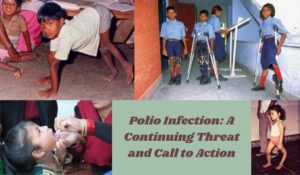Polio Infection!

Polio Infection – Introduction
Polio, a highly infectious viral disease, continues to pose a threat in various parts of the world despite significant progress toward eradication. The disease essentially influences youngsters younger than five and can prompt irreversible loss of motion or even death. The recent outbreaks of polio highlight gaps in immunisation coverage and healthcare infrastructure, threatening to undermine the achievements of the Global Polio Eradication Initiative (GPEI). This article explores the current situation, the challenges faced, and the urgent actions needed to achieve a polio-free world.
Understanding Polio Infection
Polio, short for poliomyelitis, is brought about by the poliovirus. It spreads primarily through the fecal-oral route and, in rare cases, through contaminated water or food. Once infected, the virus can invade the nervous system and cause paralysis, which is often permanent. In severe cases, it can influence the muscles that control breathing, prompting death.
Key Facts About Polio:
- Transmission: Fecal-oral route, contaminated water, or food
- Primary Victims: Children under five
- Symptoms: Fever, fatigue, headache, vomiting, stiffness in the neck, pain in the limbs
- Consequences: Irreversible paralysis, respiratory failure, death
Current Challenges about Polio Infection
Despite the near eradication of polio, recent reports indicate that the virus persists in certain regions. This resurgence is due to several factors, including:
- Gaps in Immunisation Coverage: Some areas, particularly in conflict zones or remote regions, have low vaccination rates, leaving children vulnerable to infection.
- Healthcare Infrastructure Issues: Inadequate healthcare facilities and resources hinder effective immunisation campaigns and response efforts.
- Vaccine-Derived Poliovirus (VDPV): In rare instances, the weakened virus in the oral polio vaccine (OPV) can mutate and spread in under-immunised populations, causing outbreaks.
The Global Polio Eradication Initiative (GPEI)
The GPEI, launched in 1988, has made remarkable strides in reducing polio cases worldwide. Through extensive vaccination campaigns and surveillance efforts, the number of polio cases has decreased by over 99%. However, the recent outbreaks underscore the need for continued vigilance and effort.
Achievements of the GPEI:
- Reduction in Polio Cases: From 350,000 cases in 1988 to a few hundred annually
- Polio-Free Regions: Four of the six World Health Organization (WHO) regions have been certified polio-free
- Innovative Strategies: Use of the bivalent oral polio vaccine (bOPV) and inactivated polio vaccine (IPV)
The Importance of Vaccination to control Polio Infection
Ensuring that every child receives the polio vaccine is crucial to eradicating the disease. This involves not only routine immunisation services but also targeted supplementary immunisation activities (SIAs) in high-risk areas. These efforts must be supported by robust healthcare systems and community engagement to address vaccine hesitancy and ensure wide coverage.
Key Strategies:
- Routine Immunisation: Strengthening regular vaccination programs to maintain high coverage
- Supplementary Immunisation Activities (SIAs): Conducting mass vaccination campaigns in areas with high transmission risk
- Public Awareness: Educating communities about the importance of vaccination and addressing myths and misinformation.
Call to Action
The recent resurgence of polio is a stark reminder that the fight against this disease is not over. It requires a collective effort from governments, healthcare organisations, and communities to ensure that every child is protected. We must intensify our efforts to close the immunisation gaps, improve healthcare infrastructure, and maintain vigilant surveillance.
Conclusion
The world stands at a basic crossroads in the battle against polio. While the achievements of the GPEI have brought us close to eradicating the disease, recent challenges highlight the need for continued commitment. By working together and ensuring that every child receives the polio vaccine, we can achieve a polio-free world and secure a healthier future for all children.
References
- World Health Organization (WHO). Polio Fact Sheet. Link
- Global Polio Eradication Initiative (GPEI). Link
- Centers for Disease Control and Prevention (CDC). What is Polio? Link
- UNICEF. Polio Campaigns. Link
- Mayo Clinic. Polio. Link